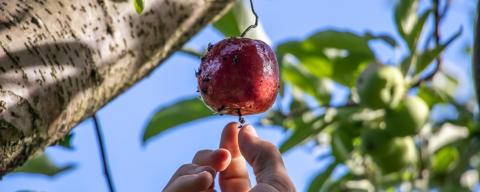Cool Cows and Happy Herds: Why Shade Matters for Livestock
Hot days are upon us here in New Hampshire, and just like you, your livestock need a break from the sun too. Providing shade doesn’t just make animals more comfortable, it reduces heat stress and leads to healthier, more productive herds.
Beef cattle can begin experiencing heat stress at temperatures as low as 77°F. When humidity rises, the temperature threshold drops even further. So, a day that feels pleasant to you may be impact your animals’ health and productivity more than you realize. Animals dealing with heat stress spend less time grazing and eat less feed. This reduced intake slows weight gain and overall performance. Other impacts include lower conception rates, shortened estrus cycles, reduced birth weights, and increased early-life mortality.

Photo source: https://newsroom.unl.edu/announce/beef/8200/47172
So, how can we help our animals beat the heat during the dog days of summer? The answer: shade and water.
Planning your pastures to include trees is one of the easiest and most natural ways to offer shade. Portable shade structures are another great option. They can be moved from pasture to pasture, which helps prevent overuse and soil compaction in one area. Since animals tend to congregate in shady spots, rotating shade locations promotes healthier pasture regrowth. More permanent options, like barns or sheds, also work well. However, they come with higher upfront costs and offer less flexibility for rotational grazing systems.
Water is just as important as shade. The location, temperature, and quality of your water source all affect animal intake. If water is too far away or not clean, animals will drink less. Just like with a lack of shade, this leads to reduced feed intake and slower growth rates. During hot months, algae and bacteria can multiply rapidly in troughs and tanks, so be sure to check and clean them regularly. Providing water in shaded areas can help keep it cooler and more appealing. If you’re using automatic refill valves, make sure they can keep up when multiple animals drink at once.
Avoiding heat stress might feel like an uphill battle, but with a few simple adjustments, you can help your livestock stay cool, healthy, and productive all summer long.
References:
Lees, A. M., Sejian, V., Wallage, A. L., Steel, C. C., Mader, T. L., Lees, J. C., & Gaughan, J. B. (2020). Review: The impact of heat load on cattle. Animal, 14(9), s133–s144. https://doi.org/10.1017/S1751731120001936
Lehmkuhler, J. (n.d.). The importance of shade and water. University of Kentucky College of Agriculture, Food and Environment. https://grazer.ca.uky.edu/importance-shade-and-water
Prater, N. (2024). Throw some shade: Protecting livestock from heat stress. ATTRA Sustainable Agriculture. https://attra.ncat.org/throw-some-shade-protecting-livestock-from-heat-stress/
Extension Services & Tools That Help NH Farmers Grow
Newsletters: Choose from our many newsletters for production agriculture
Receive Pest Text Alerts - Text UNHIPM to (866) 645-7010


